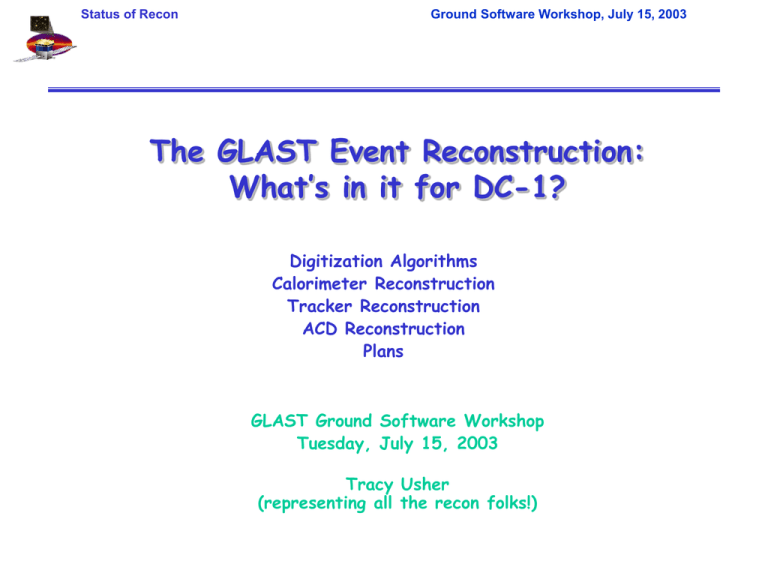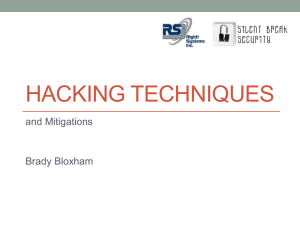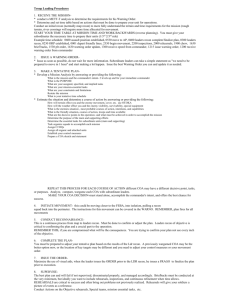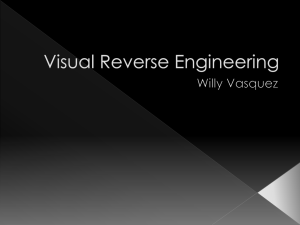The GLAST Event Reconstruction: What’s in it for DC-1?
advertisement

Status of Recon Ground Software Workshop, July 15, 2003 The GLAST Event Reconstruction: What’s in it for DC-1? Digitization Algorithms Calorimeter Reconstruction Tracker Reconstruction ACD Reconstruction Plans GLAST Ground Software Workshop Tuesday, July 15, 2003 Tracy Usher (representing all the recon folks!) Status of Recon Ground Software Workshop, July 15, 2003 Digitization Algorithms Digitization Algorithms – Geant4 tracks particles through the LAT and records interactions in “active” volumes • McIntegratingHits in the Calorimeter crystals • McPositionHits in the tracker silicon layers and the ACD tiles – Digitization algorithms then convert this MC information to simulate the electronics output Three Algorithms: – Tracker Digitization (TkrSimpleDigiAlg) • Converts McPositionHits to tracker digi output (hit strips, ToT) • (see slides) – Calorimeter Digitization (CalDigiAlg) • Converts McIntegratingHit information to digi output (ADC output) • (see slides) – ACD Digitization (AcdDigiAlg) • Etc… 2 Status of Recon Ground Software Workshop, July 15, 2003 Tracker Simulation / Digitization Geant4 treats the entire silicon plane as a unit. Energy is deposited with “landau” fluctuations. Using this information, the digitization algorithm then determines which strips are hit. cluster digis particle Mc Hit (below threshold) 3 Status of Recon Ground Software Workshop, July 15, 2003 Tracker Simulation / Digitization McPositionHit is input Digitization Algorithms: – Two Digitization Algorithms exist: • In the Simple Digitization (SimpleDigiAlg) algorithm energy deposited in the silicon is divided according to the path length (no fluctuations). – Time-over-threshold is linear in deposited energy • The Bari Digitization (BariDigiAlg) is a complete electronics simulation which accounts for fluctuations in deposited energy as the particle traverses the silicon, etc. – – More detail – much slower execution speed Currently merging two algorithms into one package • Common features in one algorithm – Bad strips, failed layers, noisy strip generation, etc. – Easy comparison of the two – cross check results • Flip of switch to change from one algorithm to the other – DC-1 will run SimpleDigiAlg • Primary issue is execution speed • Will use merged algorithm if ready soon TkrDigi is output 4 Status of Recon Ground Software Workshop, July 15, 2003 Digitization Algorithms Calorimeter Digitization – – – McIntegratingHit is input Cal Digitization: • For deposit in a crystal segment, take into account light propagation to the two ends and apply light taper based on position along the length Keep track of direct deposit in the diode Add noise to the diode Combine (with the appropriate scale factor) with crystal deposits • Add noise to “unhit” crystals; save those above threshold • Convert to ADC units and pick the appropriate readout range for hits above threshold CalDigi is output ACD Digitization – – – McPositionHit is input ACD digitization: • Energy deposited converted to PMT output (with corrections) • Tile “hit” if above threshold AcdDigi is output 5 Status of Recon Ground Software Workshop, July 15, 2003 Calorimeter Reconstruction Basic Reconstruction Goals: – Reconstruct the energy of the incident gamma ray – Reconstruct its direction – Reconstruct its position within the calorimeter This section thanks to – – Mark Strickman Berrie Giebels 6 Status of Recon Ground Software Workshop, July 15, 2003 Calorimeter Reconstruction Step 1: For Each Crystal: – Convert ADC scale to Energy measured at each crystal end • Gain and Pedestal defined from muon (ground) and cosmic ray (flight) calibrations • Integral nonlinearity defined from charge injection calibration (not available for DC-1) – Centroid position of event in crystal • Position approximately proportional to the “signal asymmetry:” – (s2 – s1)/(s2 + s1) Linear Taper – Log(s2/s1) Exponential Taper – Where s1,2 are the signals from the diodes on each end of the crystal • Current energy estimate assumes a linear response as a function of position in the crystal. – Asymmetry derived position will ultimately be used to improve crystal energy estimate (not available for DC-1) Step 2: For Each Layer: – Sum the individual crystal energies 7 Status of Recon Ground Software Workshop, July 15, 2003 Calorimeter Reconstruction Step 3: Energy Reconstruction Algorithms – Start with the total raw energy obtained from the sum over layers • Note that this raw energy does not take into account losses: – In the tracker – In the inter-tower cracks – From leakage out of the calorimeter – Get the correction to the total raw energy • Currently three algorithms available (more on these in next slides): – Shower profile fitting – Shower profile model (due to Bill Atwood) – Last layer correlation method (due to Berrie Giebels) • All three algorithms currently run in parallel • For DC-1 rely, primarily, on the Shower Profile Model Step 4: Estimation of the incident position and direction – Uses a two-dimensional energy-weighted centroid position in each layer 8 Status of Recon Ground Software Workshop, July 15, 2003 Calorimeter Reconstruction Energy Reconstruction Correction Algorithms – Shower profile fitting • “Standard” approach • Works well, especially at high energies • Not very dependent on Cal geometry details – Except for the intertower cracks • But… – Needs modification to work at all incident angles – Needs modification to account for inter-tower cracks – Shower profile model (method due to Bill Atwood) • Uses a fixed (not fitted) shower profile model with corrections for inter-tower cracks – Valid over a wide range of energies and angles (especially low energies) • But… – Requires significant tuning – Cal folks have not yet compared performance in detail to other algorithms 9 Status of Recon Ground Software Workshop, July 15, 2003 Calorimeter Reconstruction Energy Reconstruction Correction Algorithms Last layer correlation method: Use correlation between leakage and energy deposited in last layer of calorimeter to estimate leakage energy – – Generally produces better resolution than profile fitting But… • Stops working when shower profile max is outside of Cal – > 50 GeV at normal incidence • Does not work well at low energy • Parameters are dependent on Cal geometry Sample of reconstructed 2 GeV photon peak from 26° incident beam using last layer correlation 10 Status of Recon Ground Software Workshop, July 15, 2003 Calorimeter Reconstruction Last Layer Correlation Method Performance Correlation method efficiency (fraction of triggered events for which recon energy is produced) vs. polar angle for seven energies from 1-20 GeV. Inefficiency is due to failure of algorithm near cracks. Resolution vs. Energy and incident angle Berrie Giebels hard at work on this! 11 Status of Recon Ground Software Workshop, July 15, 2003 Tracker Reconstruction For DC-1, TkrRecon will go mostly “as is” – Use • • • • • Default Recon (see diagram) Cluster hit strips using standard Clustering algorithm Find candidate tracks using “Combo” Pattern Recognition Fit the track candidates with the Kalman Filter track fit Combine tracks to form vertices using the “Combo” Vertexing Algorithm Track propagation with G4Propagator – – Tied directly to the G4Geometry (and constants) Gismo getting phased out – Utilities • TkrGeometrySvc – tied to DetModel • Alignment – not needed for DC-1 • Bad strips – not needed for DC-1 • Failure modes – not needed for DC-1 – Use the Iterative Recon? 12 Tracker Reconstruction Diagram Gaudi Control Reconstruction Algorithms Gaudi Algorithms (Gaudi Tools and Classes) TkrClusterAlg Clustering: •TkrMakeClusters Transient Data Objects TkrDigiCol TkrClusterCol Pattern Recognition: •TkrComboPatRec TkrReconAlg TkrFindAlg TkrTrackFitAlg TkrPatCandCol Kalman Fitter: •KalFitTrack Track Propagator: •G4Propagator TkrVertexAlg TkrCluster TkrCluster TkrCluster TkrCluster Vertexing: TkrComboVtxRecon TkrPatCand TkrPatCand TkrPatCand TkrPatCand TkrTrackCol TkrKalFitTrack TkrKalFitTrack TkrKalFitTrack TkrKalFitTrack TkrVertexCol 13 Status of Recon Ground Software Workshop, July 15, 2003 Tracker Reconstruction Iterative Tracker Recon What is it? – – Why is it needed? – – – – The Calorimeter would like the output of TkrRecon when running the energy correction algorithms. At the same time, TkrRecon wants the best energy estimate from the Calorimeter to get the best track fits and, subsequently, the best vertices The Iterative Recon solves this problem by providing the Calorimeter Recon with sufficient tracking information to get an improved energy estimate, which can be fed back to the track fit and vertexing algorithms The process can be repeated as many times as the user likes (in principal) Will it be ready in time? – – The Iterative Recon is a mechanism for allowing parts of the Tracker Reconstruction software to be called more than once per event In particular, existing pattern recognition tracks can be refit and the vertex algorithm re-run Code already in the last three GlastRelease tags Only needs to be activated by modifying the standard recon job options file Do we want/need it? 14 Status of Recon Ground Software Workshop, July 15, 2003 Tracker Reconstruction Iterative Tracker Recon Example using “WAgammas” – – – First Pass Recon Plot Energy of the reconstructed vertex – – 1 GeV 5° cone about normal Into 6 m2 area containing Glast Red Histograms - energy of “best” vertex Blue Histograms – include energy of second track if not part of vertex In General – – Reconstructed vertex energy improves Some details to be understood • Shift in energy above 1 GeV probably still fallout (in this version of Gleam at least) of Tkr/Cal displacement • High energy tail? Second Pass Recon 15 Status of Recon Ground Software Workshop, July 15, 2003 Tracker Reconstruction DC-1 To Do list: – – – – – – Merged digitization • Not really needed for DC-1 but want to have done so that both digi algorithms will merge into the same development path Iterative Recon part of the main reconstruction loop? • Need to find source of observed energy shift in final result Try to find and remove remaining hardwired numbers • Goal: pass the Leon TkrRecon displacement test Update the TkrRecon documentation • Mainpage • Doxygen • Inline comments in updated classes General housekeeping General bug hunting • Check out “anomalous” events • Etc. Aim for updates to reconstruction algorithms in DC-2 – If anything can be found to be better than existing recon! 16 Status of Recon Ground Software Workshop, July 15, 2003 ACD Recon Primary outputs (both originally designed by Bill Atwood): 1) Active Distance: measures distance from edge (done once for entire ACD, and by region) outside tile boundary ACD_Act_Dist inside tile boundary Background no tile hit ACD_DOCA [cm] 2) Distance of Closest Approach (DOCA): measure distance from the center of a tile. Done also for different regions of the ACD, since tile size varies. Recon also provides: energy deposition estimate and counts of tiles above threshold by region. (slide courtesy of Heather Kelly) 17 Status of Recon Ground Software Workshop, July 15, 2003 Reconstruction General Questions for DC-1 Cal Recon – Tkr Recon – Do we want to include the iterative recon in DC-1? Event Summary – – When to stop “development” of energy reconstruction algorithms? TDS output class to summarize the event? What should be in this class? … 18 Status of Recon Ground Software Workshop, July 15, 2003 Recon – The Result 19



